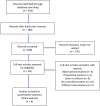The Role of Local Bupivacaine Irrigation in Postoperative Pain Control After Augmentation Mammoplasty: A Systematic Review and Meta-Analysis
- PMID: 29026810
- PMCID: PMC5626188
- DOI: 10.1177/2292550317693816
The Role of Local Bupivacaine Irrigation in Postoperative Pain Control After Augmentation Mammoplasty: A Systematic Review and Meta-Analysis
Abstract
Background: The objective of this study is to analyze the efficacy of local bupivacaine irrigation after augmentation mammoplasty for the control of postoperative pain.
Methods: A systematic review and meta-analysis was conducted including all randomized controlled trials (RCTs) that compared the irrigation of bupivacaine (±ketorolac) versus normal saline or no irrigation for pain control after breast augmentation. The primary outcome was postoperative pain measured by visual analog scale. The study protocol was established a priori according to the recommendations of the Cochrane Collaboration. A bibliographical search was conducted in September 2015 in the following Cochrane Library databases: CENTRAL, MEDLINE, EMBASE, and Scielo. The strategy used for the search was ((augmentation AND ("mammoplasty"[MeSH Terms] OR "mammoplasty")) OR (("breast"[MeSH Terms] OR "breast") AND augmentation)) AND (("pain, postoperative"[MeSH Terms])).
Results: Four RCTs with a total of 264 participants were included. Two trials compared bupivacaine alone versus placebo (normal saline or no irrigation) and 3 trials compared bupivacaine plus ketorolac versus placebo. The combined irrigation of bupivacaine and ketorolac showed a clinically significant reduction of pain in the first postoperative hour and on postoperative day 5. The irrigation with bupivacaine compared with placebo significantly reduced pain assessed on postoperative day 4.
Conclusion: The irrigation of bupivacaine with or without ketorolac was associated with a reduction of postoperative pain compared with control groups for the first 5 postoperative days. Due to the few number of trials included, these results should be correlated further clinically.
Historique: La présente étude vise à analyser l’efficacité de l’infiltration locale de bupivacaïne pour contrôler la douleur postopératoire après une mammoplastie d’augmentation.
Méthodologie: Les chercheurs ont procédé à une analyse systématique et à une méta-analyse incluant tous les essais aléatoires et contrôlés (EAC) qui comparaient l’infiltration de bupivacaïne (±kétorolac) à un soluté physiologique normal ou à l’absence d’infiltration pour contrôler la douleur après une augmentation mammaire. Le résultat clinique primaire était la douleur postopératoire mesurée d’après une échelle analogique visuelle. Les chercheurs ont établi le protocole de l’étude a priori, conformément aux recommandations de la Collaboration Cochrane. En septembre 2015, ils ont effectué une recherche bibliographique dans les bases de données suivantes de la Bibliothèque Cochrane : CENTRAL, MEDLINE, EMBASE et Scielo, à l’aide des termes suivants : augmentation ET mammoplasty (termes du MeSH) OU mammoplasty, OU breast (termes du MeSH) OU breast ET augmentation ET pain, postoperative (termes du MeSH).
Résultats: Quatre EAC, totalisant 264 participants, ont été inclus dans l’étude. Deux essais comparaient la bupivacaïne utilisée seule à un placebo (soluté physiologique normal ou absence d’infiltration) et trois essais, la bupivacaïne associée au kétorolac à un placebo. L’infiltration combinée de bupivacaïne et de kétorolac a démontré une réduction cliniquement significative de la douleur pendant l’heure suivant l’opération ainsi que le cinquième jour suivant l’opération. Par rapport à un placebo, l’infiltration de bupivacaïne réduisait considérablement la douleur évaluée le quatrième jour suivant l’opération.
Conclusion: Pendant les cinq premiers jours suivant l’opération, l’infiltration de bupivacaïne, associée ou non à du kétorolac, entraînait une diminution de la douleur postopératoire par rapport à celle ressentie par les groupes témoins. Étant donné le peu d’essais en cause, il faudrait corréler ces résultats en clinique.
Keywords: breast augmentation; bupivacaine; postoperative pain.
Conflict of interest statement
Declaration of Conflicting Interests: The author(s) declared no potential conflicts of interest with respect to the research, authorship, and/or publication of this article.
Figures



Similar articles
-
Efficacy of pocket irrigation with bupivacaine and ketorolac in breast augmentation: a randomized controlled trial.Ann Plast Surg. 2009 Jan;62(1):15-7. doi: 10.1097/SAP.0b013e31817e9c5b. Ann Plast Surg. 2009. PMID: 19131712 Clinical Trial.
-
Analgesic Effects of Locally Administered Ketorolac-based Analgesics After Breast Surgery: A Meta-Analysis of Randomized Controlled Trials.Clin J Pain. 2018 Jun;34(6):577-584. doi: 10.1097/AJP.0000000000000556. Clin J Pain. 2018. PMID: 28915151 Review.
-
Locally administered ketorolac and bupivacaine for control of postoperative pain in breast augmentation patients.Plast Reconstr Surg. 2004 Dec;114(7):1910-6. doi: 10.1097/01.prs.0000142996.50331.2c. Plast Reconstr Surg. 2004. PMID: 15577367 Clinical Trial.
-
Single-dose intra-articular bupivacaine plus morphine versus bupivacaine alone after arthroscopic knee surgery: a meta-analysis of randomized controlled trials.Knee Surg Sports Traumatol Arthrosc. 2017 Mar;25(3):966-979. doi: 10.1007/s00167-015-3748-8. Epub 2015 Aug 12. Knee Surg Sports Traumatol Arthrosc. 2017. PMID: 26264382
-
Liposome bupivacaine for pain control after total knee arthroplasty: a meta-analysis.J Orthop Surg Res. 2016 Jul 22;11(1):84. doi: 10.1186/s13018-016-0420-z. J Orthop Surg Res. 2016. PMID: 27443874 Free PMC article.
References
-
- Stutman RL, Codner M, Mahoney A, Amei A. Comparison of breast augmentation incisions and common complications. Aesthetic Plast Surg. 2012;36(5):1096–1104. - PubMed
-
- Papanastasiou S, Evans J. Postoperative analgesia in augmentation mammaplasty. Plast Reconstr Surg. 2000;105(3):1241. - PubMed
-
- Freedman BM, Balakrishnan TP, O’Hara EL. Celecoxib reduces narcotic use and pain following augmentation mammaplasty. Aesthet Surg J. 2006;26(1):24–28. - PubMed
-
- Parsa AA, Soon CWM, Parsa FD. The use of celecoxib for reduction of pain after subpectoral breast augmentation. Aesthetic Plast Surg. 2005;29:441–444. - PubMed
-
- Schneider MS. Pain reduction in breast augmentation using methocarbamol. Aesthetic Plast Surg. 1997;21(1):23–24. - PubMed
LinkOut - more resources
Full Text Sources
Other Literature Sources
